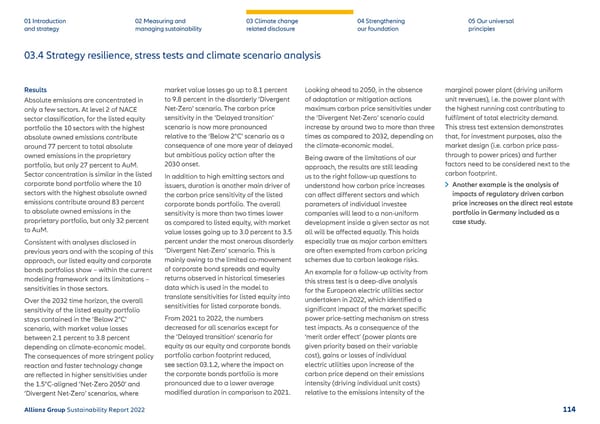01 Introduction and strategy 02 Measuring and managing sustainability 03 Climate change related disclosure 04 Strengthening our foundation 05 Our universal principles Results Absolute emissions are concentrated in only a few sectors. At level 2 of NACE sector classification, for the listed equity portfolio the 10 sectors with the highest absolute owned emissions contribute around 77 percent to total absolute owned emissions in the proprietary portfolio, but only 27 percent to AuM. Sector concentration is similar in the listed corporate bond portfolio where the 10 sectors with the highest absolute owned emissions contribute around 83 percent to absolute owned emissions in the proprietary portfolio, but only 32 percent to AuM. Consistent with analyses disclosed in previous years and with the scoping of this approach, our listed equity and corporate bonds portfolios show – within the current modeling framework and its limitations – sensitivities in those sectors. Over the 2032 time horizon, the overall sensitivity of the listed equity portfolio stays contained in the ‘Below 2°C’ scenario, with market value losses between 2.1 percent to 3.8 percent depending on climate-economic model. The consequences of more stringent policy reaction and faster technology change are reflected in higher sensitivities under the 1.5°C-aligned ‘Net-Zero 2050’ and ‘Divergent Net-Zero’ scenarios, where market value losses go up to 8.1 percent to 9.8 percent in the disorderly ‘Divergent Net-Zero’ scenario. The carbon price sensitivity in the ‘Delayed transition’ scenario is now more pronounced relative to the ‘Below 2°C’ scenario as a consequence of one more year of delayed but ambitious policy action after the 2030 onset. In addition to high emitting sectors and issuers, duration is another main driver of the carbon price sensitivity of the listed corporate bonds portfolio. The overall sensitivity is more than two times lower as compared to listed equity, with market value losses going up to 3.0 percent to 3.5 percent under the most onerous disorderly ‘Divergent Net-Zero’ scenario. This is mainly owing to the limited co-movement of corporate bond spreads and equity returns observed in historical timeseries data which is used in the model to translate sensitivities for listed equity into sensitivities for listed corporate bonds. From 2021 to 2022, the numbers decreased for all scenarios except for the ‘Delayed transition’ scenario for equity as our equity and corporate bonds portfolio carbon footprint reduced, see section 03.1.2 , where the impact on the corporate bonds portfolio is more pronounced due to a lower average modified duration in comparison to 2021. Looking ahead to 2050, in the absence of adaptation or mitigation actions maximum carbon price sensitivities under the ‘Divergent Net-Zero’ scenario could increase by around two to more than three times as compared to 2032, depending on the climate-economic model. Being aware of the limitations of our approach, the results are still leading us to the right follow-up questions to understand how carbon price increases can affect different sectors and which parameters of individual investee companies will lead to a non-uniform development inside a given sector as not all will be affected equally. This holds especially true as major carbon emitters are often exempted from carbon pricing schemes due to carbon leakage risks. An example for a follow-up activity from this stress test is a deep-dive analysis for the European electric utilities sector undertaken in 2022, which identified a significant impact of the market specific power price-setting mechanism on stress test impacts. As a consequence of the ‘merit order effect’ (power plants are given priority based on their variable cost), gains or losses of individual electric utilities upon increase of the carbon price depend on their emissions intensity (driving individual unit costs) relative to the emissions intensity of the marginal power plant (driving uniform unit revenues), i.e. the power plant with the highest running cost contributing to fulfilment of total electricity demand. This stress test extension demonstrates that, for investment purposes, also the market design (i.e. carbon price pass- through to power prices) and further factors need to be considered next to the carbon footprint. Another example is the analysis of impacts of regulatory driven carbon price increases on the direct real estate portfolio in Germany included as a case study. 03.4 Strategy resilience, stress tests and climate scenario analysis Allianz Group Sustainability Report 2022 114
 Sustainability Report 2022 | Allianz Page 114 Page 116
Sustainability Report 2022 | Allianz Page 114 Page 116